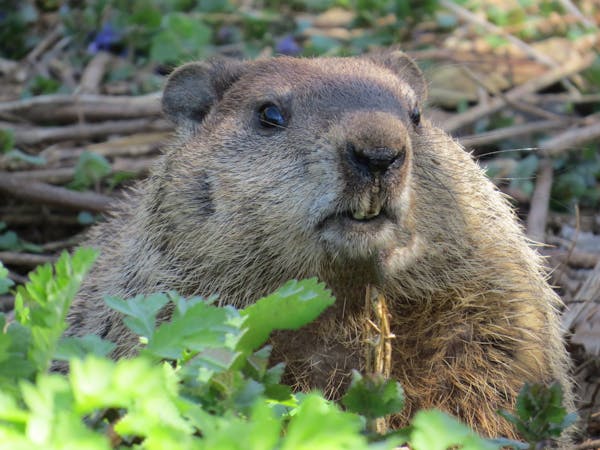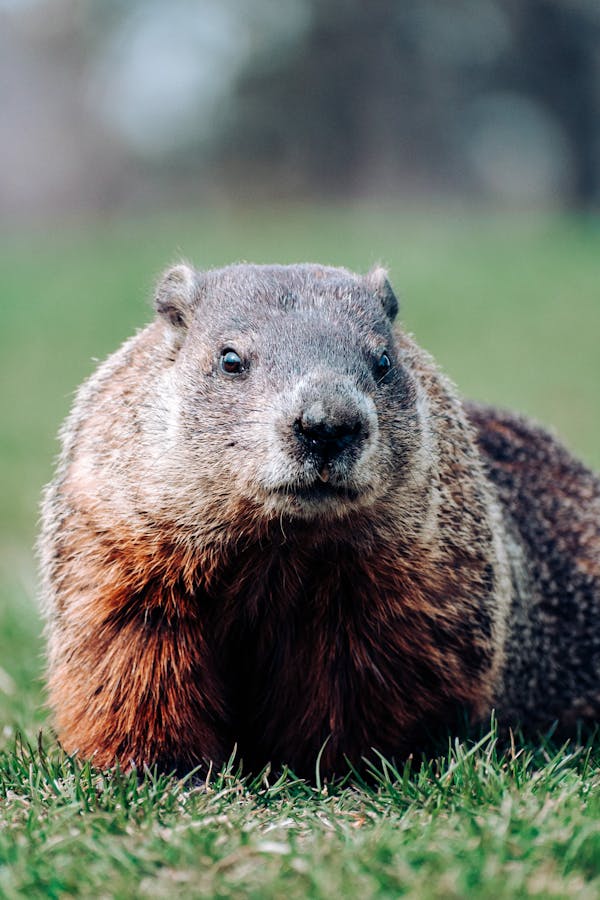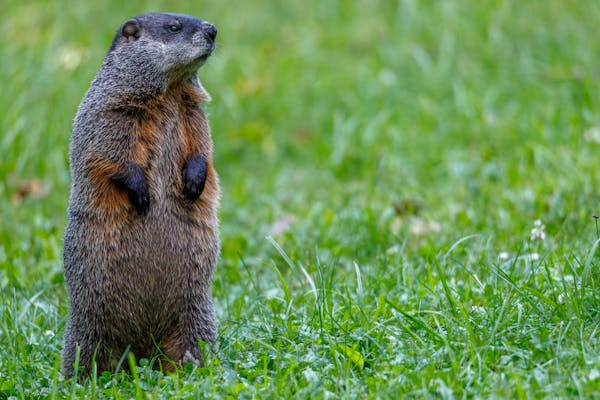Groundhog
Introduction
The groundhog (Marmota monax), also known as a woodchuck, is a rodent in the squirrel family (Sciuridae). They are found in North America, especially in the eastern and central United States and Canada. Here are some interesting facts about groundhogs:


Hibernation Experts: Groundhogs are one of the few true hibernators. They enter a deep sleep in the winter, lowering their body temperature and slowing their heart rate significantly.
Digging Masters: They are excellent burrowers and create complex underground tunnels with multiple entrances. These burrows provide shelter and are often used by other animals after the groundhog leaves.
Herbivores: Their diet consists mostly of grasses, fruits, and vegetables, though they may occasionally eat insects.
Weather Predictors?: The famous tradition of Groundhog Day (February 2) is based on the myth that a groundhog can predict the arrival of spring by seeing its shadow. In reality, groundhogs don’t have meteorological skills!Groundhogs, also known as woodchucks, have sharp senses that help them survive in the wild. Here are their key senses:
Sight – Groundhogs have good eyesight, which helps them detect predators from a distance. Their eyes are positioned high on their heads, allowing for a wide field of vision.
Smell – They rely heavily on their sense of smell to find food and detect danger. They can sniff out roots, fruits, and plants while also recognizing predators.
Hearing – Their hearing is quite sensitive, allowing them to pick up sounds of approaching threats, such as foxes or hawks.
Touch – Their whiskers help them navigate in burrows and feel their surroundings in tight spaces.
Taste – Like other rodents, they have a good sense of taste to distinguish between edible and non-edible plants.
Their sharp senses help them avoid predators and prepare for hibernation by detecting seasonal changes in their environment.Groundhogs (Marmota monax), also known as woodchucks, are a species of large ground squirrels (marmots) found in North America. Here’s an overview of their biology:
Physical Characteristics
Size: Typically 16-27 inches (40-70 cm) long, including the tail.
Weight: Usually 5-14 lbs (2-6 kg), though they can be heavier in the fall before hibernation.
Fur: Dense, coarse fur that ranges from brown to reddish-brown or gray.
Teeth: Continuously growing incisors, like other rodents.
Habitat & Distribution
Found in fields, forests, and suburban areas across most of the eastern and central U.S. and Canada.
Prefer areas with open land for foraging and nearby burrows for shelter.
Diet
Primarily herbivorous, eating grasses, clover, flowers, fruits, and crops.
Occasionally consume insects, eggs, and small animals.
Burrowing Behavior
Expert diggers, creating extensive burrow systems with multiple entrances.
Burrows can be 2-5 feet deep and 20-30 feet long.
Used for sleeping, raising young, and hibernating.
Hibernation
True hibernators: Enter deep hibernation from late fall to early spring.
Body temperature drops significantly (from ~99°F to ~37°F or ~37°C to ~3°C).
Heart rate slows from ~80 bpm to ~5 bpm.
Reproduction
Mating occurs shortly after hibernation (late winter/early spring).
1 litter per year, typically 2-6 pups.
Young are born blind and hairless, leaving the burrow after ~6 weeks.
Behavior & Communication
Solitary, except during the breeding season.
Communicate with whistles, grunts, and teeth chattering.
Can climb trees and swim when necessary.Groundhogs, also known as woodchucks, are generally shy and prefer to avoid people, but they can adapt to human presence in certain situations. Here are some common habits they exhibit around people:
General Behavior Around People:
Avoidance & Wariness: Groundhogs are naturally cautious and will usually retreat to their burrows if they sense humans nearby.
Daytime Activity: They are diurnal (active during the day), often seen foraging in yards, gardens, and fields.
Garden Raiding: In suburban or rural areas, they can become a nuisance by eating vegetables, flowers, and plants.
Climbing & Digging: Despite their stocky build, they are good climbers and can sometimes be found on fences or low tree branches.
Burrowing Near Structures: They may dig burrows under sheds, decks, or patios, which can cause structural issues.
Habituation: If they are regularly exposed to humans (especially in areas with little threat), they may become bolder and less fearful.
Responses to Human Presence:
Whistling & Chattering: They may emit a sharp whistle when alarmed, earning them the nickname “whistle pig.”
Freeze & Flee: If startled, they often freeze before running to the nearest burrow.
Standing on Hind Legs: They sometimes stand upright to survey their surroundings.
Rare Aggression: While usually non-aggressive, they may bite or scratch if cornered or threatenedGroundhogs (also known as woodchucks) are herbivores, primarily feeding on a variety of plants. Their diet consists of:
Primary Foods
Grasses and clover – They love fresh greens.
Flowers and garden plants – They often eat daisies, dandelions, and other common flowers.
Vegetables – They enjoy crops like lettuce, carrots, beans, peas, and corn.
Fruits – Berries, apples, and other soft fruits are common in their diet.
Occasional Foods
Tree bark and twigs – Mostly in winter when other food is scarce.
Insects and small animals – Rarely, they may eat grubs, snails, or even bird eggs.
Groundhogs are known for raiding gardens, which makes them a nuisance for farmers and gardeners. They prefer fresh, tender plants but will also eat stored food in preparation for hibernation.roundhogs (also known as woodchucks) typically live around 6 years in the wild, though some may reach up to 8 years. In captivity, where they are protected from predators and environmental hazards, they can live up to 14 years. Their lifespan is often shortened in the wild due to predators, disease, and harsh winters.Living with groundhogs (also known as woodchucks) can have some surprising benefits, though they are often seen as garden pests. Here are a few positive aspects:
- Soil Aeration & Composting
Groundhogs dig extensive burrows, which help aerate the soil, improving drainage and promoting root growth. Their discarded food scraps can also contribute to natural composting.
- Pest Control
Though they eat plants, groundhogs also help control insect populations by consuming beetles, grubs, and other pests in their environment.
- Wildlife Observation
Watching groundhogs can be entertaining. They are intelligent, social animals with playful behaviors that can be fun to observe.
- Ecological Contributions
Their burrows provide shelter for other wildlife like rabbits, foxes, and burrowing owls once abandoned. They play an important role in the ecosystem.
- Natural Weather Forecasters
Folklore suggests groundhogs can predict the weather—whether or not it’s accurate, they do have seasonal habits that signal seasonal changes.
- Educational Value
For families or nature lovers, having groundhogs around can be a great way to learn about wildlife and ecosystems firsthand.
Diseases

Groundhogs, also known as woodchucks, are susceptible to various diseases and viral infections. Some of the common diseases and infections they may carry include:
Rabies: This is a viral infection that affects the nervous system and can be transmitted through bites. While groundhogs are not among the most common carriers, they can become infected. Rabies in groundhogs can lead to abnormal behavior, aggression, and paralysis.
Plague: Groundhogs are known to carry fleas, which can transmit Yersinia pestis, the bacteria responsible for the plague. This disease can affect both humans and animals, causing symptoms like fever, swollen lymph nodes, and in severe cases, death.
Tularemia: Caused by the bacterium Francisella tularensis, tularemia is a highly infectious disease that groundhogs can carry. It can be transmitted to humans through contact with infected animals or their tissues, or through tick bites. Symptoms in humans include fever, chills, and swollen lymph nodes.
Lyme Disease: While ticks are the primary vector for Lyme disease, groundhogs can be hosts to ticks, particularly the deer tick (Ixodes scapularis), which can transmit the bacteria Borrelia burgdorferi. Humans who are bitten by infected ticks may develop symptoms like fever, fatigue, and a characteristic bull’s-eye rash.
Ectoparasites: Groundhogs can harbor various ectoparasites, such as fleas, ticks, and mites. These parasites can carry and spread diseases like Lyme disease and tularemia, as well as cause irritation or infection in the groundhog itself.
Leptospirosis: This bacterial infection, which is spread through the urine of infected animals, can potentially affect groundhogs and can be transmitted to humans. It can cause symptoms like fever, muscle aches, and in severe cases, liver and kidney failure.
Giardia and Other Protozoa: Groundhogs, like many wild animals, can be infected with Giardia, a protozoan parasite that causes gastrointestinal issues like diarrhea. This can potentially be transmitted to humans through contaminated water sources.
In general, humans should exercise caution when handling groundhogs or coming into contact with their habitats. If you encounter a sick or dead groundhog, it’s a good idea to avoid direct contact and to report it to local wildlife authorities to minimize the risk of zoonotic diseases.